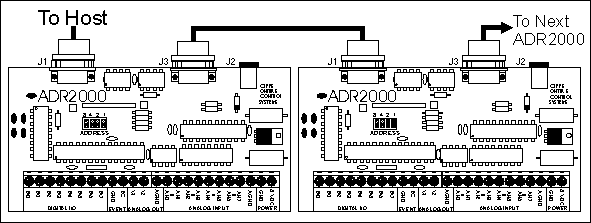|
( See section B below for daisy-chaining
ADR1000 series.)
All ADR2000
 series products have identical serial
communication and daisy chain capabilities. J1 has both an RS232 and RS485 port
available while J3 is RS485 only. The first board in the chain connects to the
Host computer via RS232 or RS485 ( J1 ). Subsequent boards may then be daisy chained
using the RS485 port on J3. This allows daisy-chaining of up to 10 ADR2000 series boards
in any combination with a single twisted pair cable. Power may also be jumpered if a two
pair cable is used. This allows all boards on the chain to be powered by a single power
supply. series products have identical serial
communication and daisy chain capabilities. J1 has both an RS232 and RS485 port
available while J3 is RS485 only. The first board in the chain connects to the
Host computer via RS232 or RS485 ( J1 ). Subsequent boards may then be daisy chained
using the RS485 port on J3. This allows daisy-chaining of up to 10 ADR2000 series boards
in any combination with a single twisted pair cable. Power may also be jumpered if a two
pair cable is used. This allows all boards on the chain to be powered by a single power
supply.

Typical Daisy-Chain Connection for ADR2000 Series Interfaces
Each board in the chain is given an address from 0 -9 via address
jumpers on the ADR2000 series interfaces. When the address is set, that board responds
only to commands preceded by that number. For example, to read analog port 4 on board 3
the following command is used;
3RD4<cr>
A very unique feature of this daisy-chain system is the fact that
all ADR2000 series boards have a complete RS232 to RS485 transceiver on-board. This allows
the use of RS232 devices at any node in the chain using the spare RS232 port. The host can
then communicate transparently to that device provided its command syntax is not the same
as the ADR2000 series products.
Section B: Daisy Chaining
ADR1000 Series
Daisy-chaining ADR1000 boards is possible
using RS485, RS422 or RS232. When using a standard RS232 port, the first board on
the chain echos commands via an RS485 link to other boards. the following is a page from
the ADR1000 user manual showing the daisy-chaining options.

Back to Applications Page |